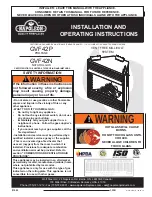
37
BULLETIN 52
LEAKING TEMPERATURE AND PRESSURE RELIEF VALVE
SYMPTOMS
•
Water seeping around the relief valve tank connection
•
Leakage at the threaded portion of the relief valve connection
•
Intermittent weeping and/or dribbling from the relief valve
•
Large volume of hot water sporadically discharged from the relief valve
GENERAL
The temperature and pressure relief valve (T & P) is a safety device limiting
temperature and pressure levels in a water heater. Each T & P has both a temperature
and pressure rating.
Normally, the temperature and pressure relief valve will have a temperature rating of
210°F. A probe (part of the relief valve) extends into the tank measuring the stored
water temperature. This probe must be within the top six inches of the water heater.
If the water heater’s thermostat malfunctions, higher than normal water temperatures
could be produced. Once the probe senses a temperature approaching its temperature
rating, the relief valve will open to full capacity releasing “very hot” water until the
temperature is below its reset temperature.
The pressure rating on the relief valve should be the same or less than the certi
fi
ed
working pressure of the tank (generally 150 psi) and be below the lowest maximum
working pressure rating of any system components. Once the pressure in the tank
reaches the valve’s pressure rating, it will slightly open relieving the pressure. Relieving
of pressure can be noted as “dribbling” or “weeping” water from the relief valve.
If an incorrectly sized temperature and pressure relief valve is installed, the warranty
will be void.
THE FIX
Follow these easy steps to diagnose thermal expansion:
•
Intermittent weeping and/or dribbling at the relief valve
- The relief valve
relieves water slowly when actuating on pressure. A closed system can cause
pressure to increase in the system. This condition is called thermal expansion. For
additional information regarding thermal expansion please see Bulletin 45.
•
Leaking at the spud of the water heater
- Spuds are welded to the tank and are
not repairable. The heater should be replaced.
•
Leakage at the threaded relief valve connection
- Remove relief valve and
reseal connection.
•
Large volume of hot water sporadically discharged from the relief valve
- The
relief valve relieves water quickly when actuating on temperature. The only cause
of this problem is a malfunctioning thermostat.








































